We’re bringing you our favorite list of purple crystals ranging from common and well-known crystals to rare and hard-to-find varieties. One thing they all have in common is they are all a shade on the purple spectrum.
One of the rarer colors in the mineral realm is purple but the variety of crystals is never lacking.
List of Purple Crystals
While interested and experienced rockhounds can likely list off a handful or more of purple-colored crystals, the first popular one that comes to mind is amethyst. But let’s dig into this list to see what other crystals are in the purple spectrum.
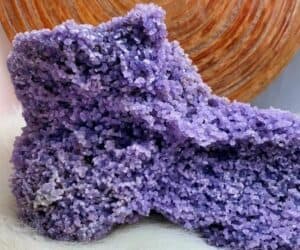
Grape Agate
Grape Agate displays one of the most prominent botryoidal formations in nature. They’re almost always comprised of small round nodules interlocked into masses resembling a bunch of grapes. This strange and unique stone is newly discovered and highly valuable. While most grape agates are purple, green varieties also exist.
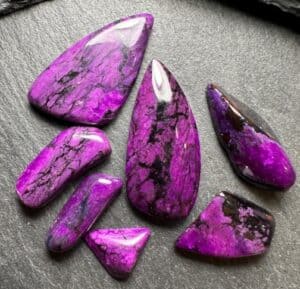
Sugilite
This new addition to the universe of gemstones is an extremely rare silicate mineral found only in a few places on the planet. Sugilite’s rich purple coloration and mottled appearance are attractive; combined with the stone’s rarity, there’s a serious market for these crystals with sky-high pricing.
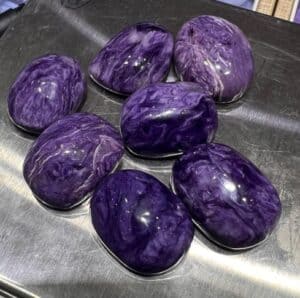
Charoite
Charoites are so deeply colored that many people assume they’re dyed. This crystal bears purple colors with swirls, creating a unique surface finish when polished. The pattern is best described as marbled. Charoite is another rare stone, with reports that there only found in one region of Siberia.
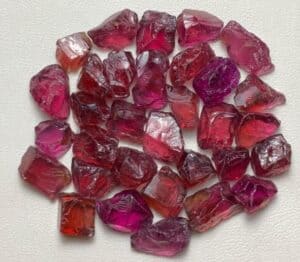
Rhodolite Garnet
Garnets are an obsession for many because they can be found in a rainbow of colors but rhodolites are highly sought after. Its deep purple-red hues quickly capture your attention and the varying saturations give the collector a variety of stones to choose from.

Amethyst
This iron-infused variety of quartz displays a wide range of purple colorations and hues. Shades range from light lavender to deep purple. Siberian amethyst is the most saught after and demands the highest price per carat of all the amethyst varieties.
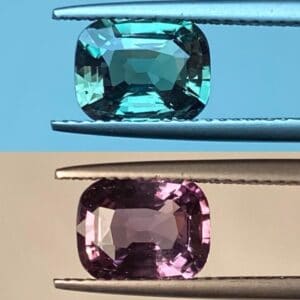
Alexandrite
This precious gem is one of the most expensive on the planet due to low supply and its color-shifting properties. Deep purple Alexandrite presents itself in incandescent light, but when the sunlight falls directly on it, the color transforms into a teal color. Some of the highest quality pieces are sourced from Russian mines.
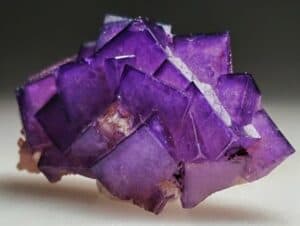
Purple Fluorite
Fluorite comes in various colors and shapes but as of late the purple and blue hues have become extremely popular among specimen and crystal collectors. The crystal structure makes it a must-have for anyone’s collection because the stacking of square crystals on top of each other makes it so unique.
Fluorite is on the soft side which makes it easy to carve but not so great for jewelry. If you have a 10x powered loop then you’ll notice an incredible blend of internal fractures and included crystals.
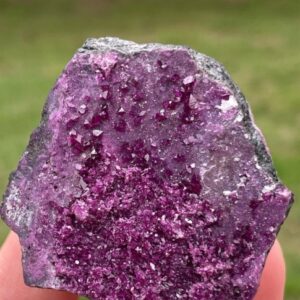
Kammererite
Kammererite is an extremely soft mineral found in densely packed formations of crystals growing on matrix. It’s main source is Italy and is often confused with amethyst at first glance but if you look closely you’ll notice a completely different crystal structure.
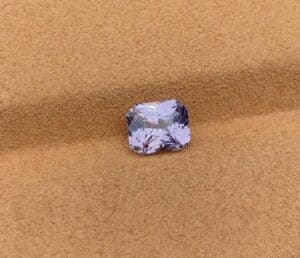
Taaffeite
You should check into the origin story of Taaffeite because it’s a great one. Taaffeite is the only stone to be initially identified as a cut gemstone. This crystal was identified by a gentleman named Richard Taafe, who found it had a few discrepancies with Spinel it was being sold as.
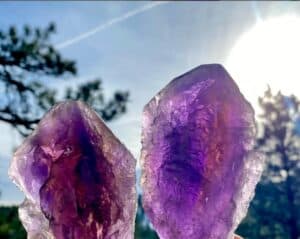
Ametrine
The name “Ametrine” is a combination of each stone’s name, amethyst and citrine which are varieties of quartz. Crystals exhibiting deep colored zones with a well-defined line between them demand the highest price per carat. Most, if not all of the natural ametrine comes from a single mine in Bolivia but the buyer should be aware of the large quantities of synthetics on the market.
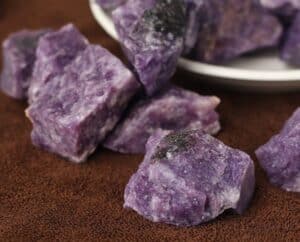
Lepidolite
This crystal is primarily known for being an ore for rare earth metals lithium and rubidium but they’re formed as lilac-to-light purple stones. It didn’t take long for lepidolite to take its place in the rock and mineral world because it’s easy to tumble and turn into beautiful cabochons.
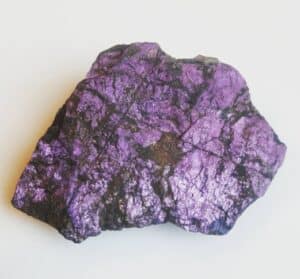
Purpurite
Purpurite is a manganese iron phosphate with a deep purple coloration. Its incredibly striking appearance is out of this world and is not very common which means you won’t be seeing a lot of rough at the local rock and mineral shows. Some of the best-known specimens hail from Namibia.
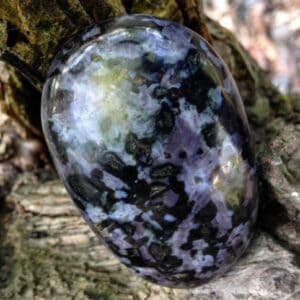
Indigo Gabbro
Indigo Gabbro is well suited for carving and cabochons because it is attractive and incredibly affordable. These conglomerates are made up of grains or material ranging from a light lavender color to a deep purple-blue, intermixed with black blotches. The Earth’s final product is a stunning stone that doesn’t get nearly enough of the spotlight or credit.
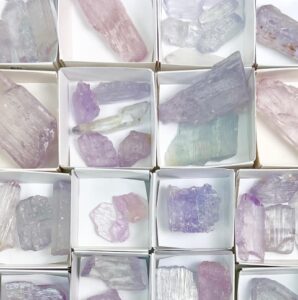
Kunzite
Kunzite is a gem variant of Spodumene found in pink to light purple colors. While Spodumene is a common mineral, it only occurs in a few locations as a transparent gem. Kunzite is the most common Spodumene found, with the rarest variety being Hiddenite.
Light Purple Crystals
- Grape Agate – Pale whitish-purple to deep purple.
- Charoite – Lilac to deep violet.
- Rhodolite Garnet – Colors can range from light to dark purple.
- Amethyst – Lilac to purple to dark purple.
- Purple Fluorite – Ranges from light to dark shades.
- Taaffeite – Light to violet purple.
- Ametrine – Light purple to a rich violet.
- Lepidolite – Light purple to purple colors.
- Kunzite – Shades of light violet.
- Alexandrite – Light violet.
Dark Purple Crystals
- Sugilite – Violet to deep rich shades of purple.
- Kammererite – Violet to purple to dark purple.
- Purpurite – Reddish purple to dark purple.
- Indigo Gabbro – Indigo to purple to blackish-purple.
I’m sure you’ve noticed that some stones on each list can vary in shade. That said, some specimens are suitable in both light and dark categories.
- Identify Enstatite - March 12, 2024
- Identify Cerussite - March 3, 2024
- Identify Bytownite - February 18, 2024
